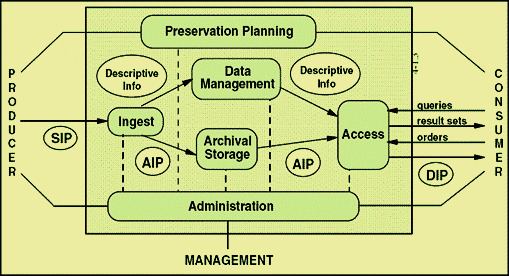 | ||
An Open Archival Information System (or OAIS) is an archive, consisting of an organization of people and systems, that has accepted the responsibility to preserve information and make it available for a Designated Community.
Contents
- Requirements of the system
- The OAIS environment and information model
- The functional model
- Adoption
- References
The term OAIS also refers, by extension, to the ISO OAIS Reference Model for an OAIS. This reference model is defined by recommendation CCSDS 650.0-B-1 of the Consultative Committee for Space Data Systems; this text is identical to ISO 14721:2003 which is superseded by ISO 14721:2012. The CCSDS's purview is space agencies, but the OAIS model it developed has proved useful to a wide variety of other organizations and institutions with digital archiving needs.
The information being maintained has been deemed to need "long term preservation", even if the OAIS itself is not permanent. "Long term" is long enough to be concerned with the impacts of changing technologies, including support for new media and data formats, or with a changing user community. "Long term" may extend indefinitely. In this reference model there is a particular focus on digital information, both as the primary forms of information held and as supporting information for both digitally and physically archived materials. Therefore, the model accommodates information that is inherently non-digital (e.g., a physical sample), but the modeling and preservation of such information is not addressed in detail. As strictly a conceptual framework, the OAIS model does not require the use of any particular computing platform, system environment, system design paradigm, system development methodology, database management system, database design paradigm, data definition language, command language, system interface, user interface, technology, or media for an archive to be compliant. Its aim is to set the standard for the activities that are involved in preserving a digital archive rather than the method for carrying out those activities.
The acronym OAIS should not be confused with OAI, which is the Open Archives Initiative.
Requirements of the system
The reference model (ISO 14721:2003) includes the following responsibilities that an OAIS archive must abide by:
The OAIS environment and information model
The OAIS environment involves the interaction of four entities: producers of information, consumers of information (or the Designated Community), management, and the archive itself. The management component of the OAIS environment is not an entity that carries out day-to-day maintenance of an archive but a person or group that sets policies for the content contained in the archive.
The OAIS model also defines an information model. Physical or digital items which contain information are known as data objects. Members of the Designated Community for an archive should be able to interpret and understand the information contained in a data object either because of their established knowledge base or with the assistance of supplementary "representation information" that is included with the data object.
An information package includes the following information objects:
There are three types of information package in the OAIS reference model:
These three information packages may or may not be identical to each other.
The functional model
There are six functional entities in an OAIS:
Adoption
Although originally developed by the CCSDS, a body dedicated to overseeing space agencies, as digital preservation has become a discipline unto itself, the OAIS has become the standard model for digital preservation systems at many institutions and organizations. OAIS-compliance has been a stated fundamental design requirement for major digital preservation and repository development efforts at the National Archives and Records Administration, Library of Congress, British Library, Bibliothèque nationale de France, National Library of the Netherlands, the Digital Curation Centre in the UK, OCLC (the Online Computer Library Center), the JSTOR (Journal Storage) scholarly journal archive, as well as several university library systems. The OAIS has been the basis of numerous prominent digital preservation initiatives and standards including the Preservation Metadata: Implementation Strategies working group and the Trustworthy Repositories Audit & Certification (TRAC) document from OCLC.
